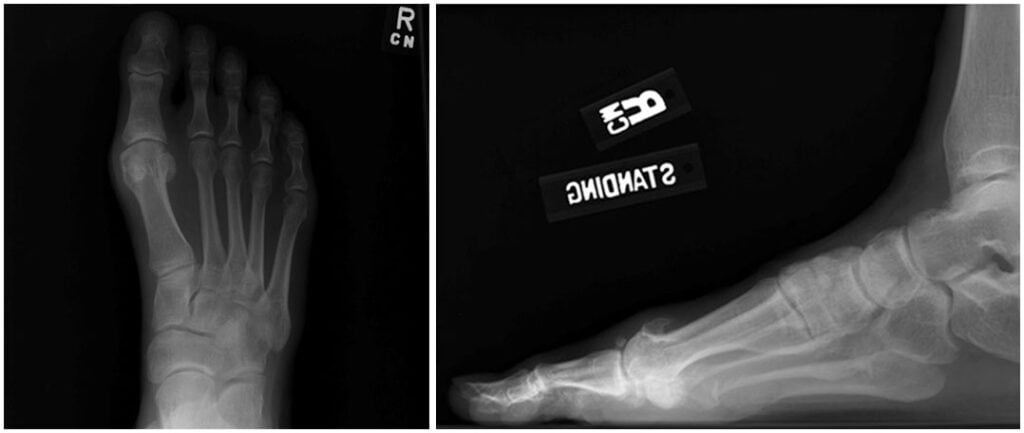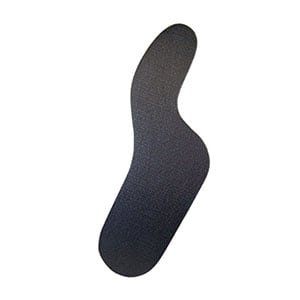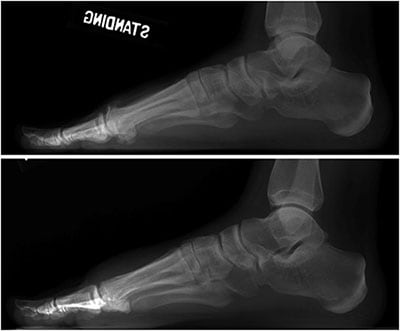What is it?
Arthritis is a degenerative disease of cartilage (smooth lining of the joint surfaces). Arthritis in the big toe is the most common arthritic condition in the foot, affecting 1 in 40 people over the age of 50. Females are more commonly affected, and the condition typically develops between the ages of 30 and 60 years.
The condition can be particularly life altering— limiting a person’s ability to perform activities that were once enjoyable to them, producing pain and restricting shoe options.
Symptoms and Clinical Presentation
Most patients complain of pain in the big toe joint, especially when pushing off to walk. Patients notice stiffness and swelling in the big toe, and a large bump on the top part of the toe that can interfere with shoes.
Diagnosis
Most cases can be diagnosed based on clinical history and physical examination alone. X-rays are important to help understand the extent of the arthritis and the size and location of the bone spurs.

XRays demonstrating joint space narrowing and a large bone spur off the top of the first metatarsal
Treatment Options
Non-surgical treatment
Non-surgical treatment is the first-line treatment and consists of anti-inflammatory medications, ice, and changes in which shoes you wear to avoid flexible, narrow shoes.
Shoe inserts (Morton’s extension) can be helpful to limit motion at the big toe joint and relieve pain. Occasionally steroid injections can offer some symptom relief but do not reverse the arthritic process.

Morton’s extension insert
Surgical treatment
If the non-surgical treatment options have failed, there are surgical options for the treatment of big toe arthritis.
Cheilectomy (bone spur removal)
A cheilectomy, or bone spur removal, involves shaving the bone spur off the top and sides of the joint. This procedure is reserved for more minor arthritis.
A cheilectomy provides reliable improvements in shoe wear difficulties, good pain relief, and mild improvement range of motion. It allows patients a quick recovery with the ability to weight bear (stand up and put weight on your feet) as tolerated immediately after the surgery.
The major disadvantage of this surgery is that if the arthritis progresses, the patient may require a second surgery in the future.

Appearance before surgery of the bone spur (top image) and the appearance after surgery (bottom image) following a cheilectomy
Arthrodesis (fusion)
Advanced stages of arthritis have traditionally been treated by a surgical fusion of the big toe. In this procedure, the damaged cartilage is removed, and the two bones of the joint are fixed together with plates and screws to allow them to heal together. This procedure removes all remaining motion from the big toe joint.
Fusion is very reliable at eliminating pain permanently from the joint. Studies have shown good restoration in the gait with very few functional limitations. This surgery is also an excellent option for patients with arthritis associated with deformity of the toe.
The major disadvantage of this surgery is that a good result is a completely rigid joint. This result will negatively affect patients that wish to run or participate in activities requiring motion of the big toe (such as many yoga poses). The recovery is longer than the bone spur removal, requiring weight bearing on the heel for 6 weeks after the surgery, and approximately 3 months until the patient is able to walk in normal shoes. Additionally, there is a small chance that the bones won’t grow together (called a nonunion), which requires another surgery to address.

Appearance before surgery (left image) of severe joint space narrowing and arthritis of the big toe and appearance after surgery (right image) of the fusion (arthrodesis) procedure.
Toe replacement
Both total toe replacement (both sides) and hemiarthroplasty (half of the joint) have been investigated for the treatment of big toe arthritis. A good toe replacement would relieve pain, restore motion, and improve function. Also, it would be durable, and able to be revised if it were to fail.
Unfortunately, there is insufficient evidence in the orthopedic studies to support the use of replacements for the big toe. Many of the implants are complicated by early loosening of the implants, stiffness, and failure requiring complex revision surgeries.
Ultimately, the treatment of arthritis of the big toe requires a shared decision-making process between you and your fellowship-trained foot and ankle orthopedic surgeon. Fortunately, there are many non-surgical, and surgical options available to help provide you with adequate pain relief that will help keep you active.

